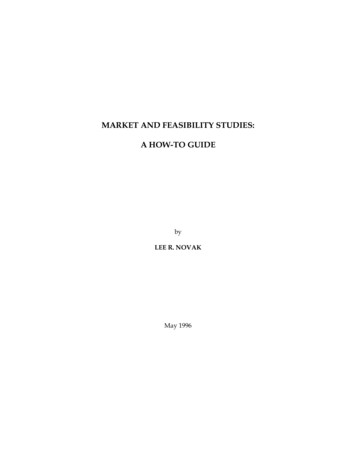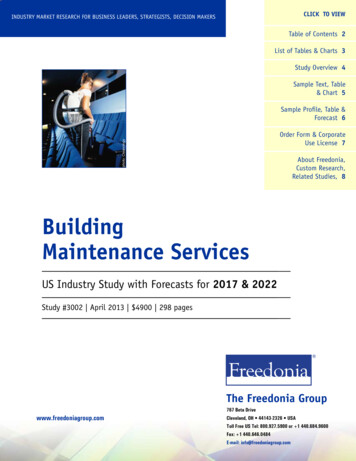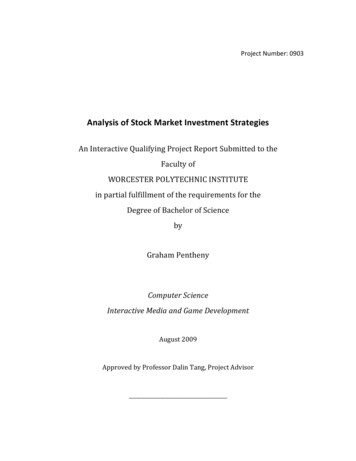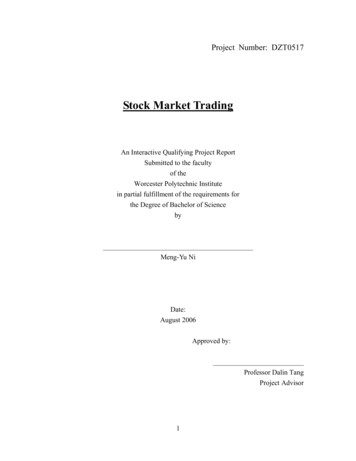
Transcription
MARKET AND FEASIBILITY STUDIES:A HOW-TO GUIDEbyLEE R. NOVAKMay 1996
Table of ContentsIntroduction . 3What Is A Market And Feasibility Study?. 4Who Uses Market And Feasibility Studies? . 6Developers . 7Architects. 7Land planners and engineers . 8Lending institutions and REITs . 8Government planners. 8Elected Officials. 9Who Performs Market And Feasibility Studies? . 9Developers . 9Architectural, engineering and planning firms . 9Lending institutions and other investors. 10Government planners. 11Market analysts and other real estate consultants . 11What Are The Types Of Market And Feasibility Studies? . 11Back of the envelope . 11Appraisal . 12Cost-benefit analysis. 12Analysis of economic base . 12Analysis of economic impact. 12Land use study . 13Marketability study . 13Study of highest and best use. 13Market study. 14Financial feasibility analysis. 14How Are Market And Feasibility Analysis Performed? . 15Project development . 15The market analysis . 16The feasibility analysis . 26What is the best way to present the results? . 31What Are Some Common Mistakes In Performing Market And Feasibility Studies? . 33Consultant methodology . 33Poor data . 34Consultant bias . 34Conclusion . 35Sources. 35Market & Feasibility Studies: A How-To GuidePage 2
IntroductionDuring the 1980's, the halcyon years of real estate development, new projects weredeveloped on an epic scale. Millions of square feet of retail, office and residential spacewere built in the United States, especially in the Sunbelt states of the south. Loans wereeasy to come by and interest rates were low. Savings and Loans were handing out fundslike candy to trick-or-treaters. Despite the boom, much of this development remainedvacant or without buyers and had enormous debt burdens.The cycle of bad loans and failed projects was evident by the mid-1980's, but it wasn'tuntil the late 1980's that the Savings and Loan crisis broke. Savings and loan institutionswere supposed to be safe places for people to keep their money and to obtain moderatehome loans, but the 1982 deregulation had allowed these institutions to fund any type ofproject.As S & L's crashed, it became evident that a huge bailout would be necessary. TheResolution Trust Corporation was formed for this task. The cost was original predictedto be 50 billion, but has risen to between 500 billion and 1 trillion dollars. Theeventual burden on the taxpayers could be 2,000 per capita.What do bad loans and failed banks have to do with market and feasibility studies?Everything. One of the main causes for the S & L debacle is bad loans made withoutaccurate information showing whether a project could succeed. During the 1980's loanswere made to developers based on past successes. Instead of a critical look at the projectby the lender, loans were granted for the ability to put up buildings quickly andcheaply.An Example: The McKenzie SportsArena Market Analysis andPreliminary Feasibility StudyIn December of 1996, the CommunityPlanning Workshop (CPW) was hired byBroad Base Programs, Inc. to analyze themarket for a large scale multiple sportsArena. The facility would be a large scalequasi-public development. In order toobtain market information CPW performedan extensive study. Throughout this reportwe will trace the path that CPW took inwriting the market analysis. Each gray boxwill outline a different portion of the studyand the process.Banks are more wary now, and they arerequired to be. A market and feasibilitystudy will be necessary for almost anydevelopment project to obtain funding. Notjust a necessity for funding, a market studyhelps avoid bad projects when used by thedevelopment team to design the project andfor marketing. Even public projects arerequiring more detailed studies for capitalprojects. Planners often write and reviewmarket and feasibility studies for both publicand private projects.This chapter outlines the basics of marketand feasibility studies. We will begin bydescribing what a market and feasibilitystudy is and its place in the development process. Next, we will examine who usesthese studies, who writes them and what types of market studies exist. Then we will goMarket & Feasibility Studies: A How-To GuidePage 3
through the steps in performing a market study. Next, we provide some advice ondelivering the results. We conclude with a look at common errors made in the process.What Is A Market And Feasibility Study?Most people lump market and feasibility studies together, but they are two differententities and typically occur at different times in the development process. In general, amarket analysis searches for the intersection of demand and supply that will create amarket for a product at a given price, and a feasibility analysis tests whether a certainproduct will meet certain financial or social goals in the market. As Figure 1 shows, amarket analysis is performed early in the process, while a feasibility analysis isperformed after initial design and during design refinements.Figure 1The Real Estate Development ProcessIdea inceptionNot feasibleFeasibleIdea refinementNot feasibleFeasibleMarket analysisNot feasibleFeasibleProject designNot feasibleFeasibleFeasibility studyNot feasibleFeasibleContracts & entitlementsNot feasibleFeasibleConstructionMarket & Feasibility Studies: A How-To GuidePage 4
Property managementDevelopers usually have some sense of the market when they first consider a site ordevelopment concept. As entrepreneurs, they are constantly following trends, watchingother developers and looking for new niches to fill in the market. Based on thisknowledge, a developer will identify an opportunity and create a concept for takingadvantage of that opportunity. This initial idea will make intuitive sense to thedeveloper, but gut feelings are not a sound basis for investing thousands or evenmillions of dollars in construction.The developer needs more detailed information about the market before proceedingeven to the preliminary design phase. Here is where the market analysis comes in. Themarket analysis helps the developer answer a series of questions to refine the projectconcept. For example a residential developer would want to know answers to thefollowing questions: What are the employment trends in the market area?What is the population growth rate in the market area?What is the best configuration and size of units for the proposeddevelopment?How many units can the market absorb, at what price and over what lengthof time?What percent of market demand will the project capture and why?How should units be marketed to the target customers?How much operating revenue or income can this project expect to generateover a certain time?What are the regulatory controls placed on this type of development?What is the communities position on the potential development in theproposed location? (Miles, 11)Other types of developers such as commercial and industrial builders will want toanswer similar questions. This information is essential for proceeding with design, fundraising and eventually marketing. The developer will share the information witharchitects, engineers and landscape architects who will develop a more refined site plan.Architects will use the information to decide on building type and amenities, engineerswill use the information to plan for infrastructure and landscape architects will designhow the buildings should be placed on the site.The next step is the feasibility study. Based on the designs, the developer will obtainconstruction and other project costs. The analyst who performs the feasibility study willtest whether the expected revenues which were generated in the market analysissufficiently exceed the expected costs. In most cases, the project is required to generate adollar return commiserate with the amount of risk involved in order to proceed.In certain public projects, a policy decision may be made that the projects contribution tothe community is more important than making money. For example, manycommunities build stadiums using debt financing such as bonds. Cities may not expectMarket & Feasibility Studies: A How-To GuidePage 5
to generate profit on their investment, but hope that spin-offs and residual effects ofdevelopment will increase the community's general well being. While feasibility studiesshould consider other non-monetary risks and opportunities, for most developers andinvestors the bottom line is delivered in dollars and cents.If the feasibility study is positive, the project may move forward. The developer will usethe study to obtain funding from investors and developers, contracts will be signed withbuilders, and marketing efforts will start. If the feasibility study is negative, thedeveloper may decide to abandon the project despite having invested thousands in astudy. The developer may also return to the design team and search for ways to makethe project profitable. The development team may change the combination of amenities,increase density, obtain better loan rates or even completely switch the type ofdevelopment. The developer and market analyst will become involved in aninformation feed-back loop until all the permits are obtained. At this point, it typicallybecomes too expensive to change the project.It would seem that the market analysis is no longer necessary once construction hasbegun, but much of the information can be used in marketing the project. The marketanalysis defined the market segment and differentiated the project, two tasks necessaryto target customers. To keep the information pertinent, the study should be updatedthroughout the development process.The market and feasibility study is an integral part of the development process. Donecorrectly and at the right time in the development process, it can prevent major projectfailures an
During the 1980's, the halcyon years of real estate development, new projects were developed on an epic scale. Millions of square feet of retail, office and residential space were built in the United States, especially in the Sunbelt states of the south. Loans were easy to come by and interest rates were low. Savings and Loans were handing out funds like candy to trick-or-treaters. Despite the .File Size: 452KBPage Count: 35











